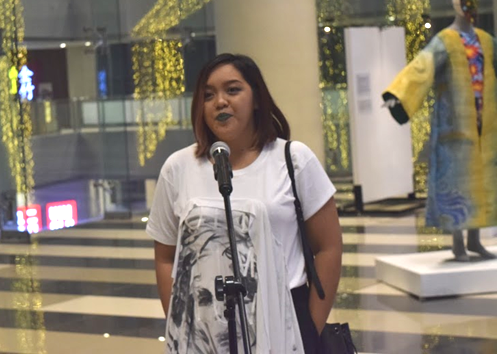
The collapse of the Rana Plaza Building, which had five garment factories, in Bangladesh on April 24, 2013, is one of the most tragic recorded industrial accidents. It also opened the minds of the public to the poor labor conditions experienced by workers in the ready-made garment sector in the country.
As a direct response to this tragedy, Fashion Revolution was born. The organization is a global movement which also has a team in the Philippines. And on the 24th of October, Fashion Revolution Philippines opened its first exhibit: “The Walk-Through,” held at Ayala Malls in Circuit Makati.
Initiating Conversations About Sustainable Fashion

Photo by the writer
“The Walk-Through” is a group show of multi-disciplinary Filipino artists. According to the organizers, the four-day exhibition aims to “provoke curiosity with Work that immerses in the multiverse of complex aspects of our generation’s fashion revolution.”
This event is also the first artist collaboration activation of Fashion Revolution Philippines that uses creative media to communicate issues plaguing the global fashion industry. The British Council supported the project as part of the Creative Commissions initiative, which inspires positive change through artistic collaborations challenging the social and environmental issues around sustainability and fashion.
Additionally, the organizers chose a mall as a venue is because they wanted a place where consumption takes place. They transformed it into the place of cultural, economic, social, and political connections.
Multi-Disciplinary Filipino Artists Taking the Conversation Further
Six Filipino artists, namely Anina Rubio, Pam Quinto, Tanya Villanueva, TeklaTamoria, and Zeus Basco x Jas Fernandez, showcased their artworks during the exhibition. Each artist tackles different issues in the Fashion industry, including its environmental impact, excessive textile waste, and sustainability.
“Agua Caja” by Anina Rubio

Photo by the writer
Rubio’s work focuses on the environmental impact of fashion choices, mindful consumerism, and living sustainably, which is through supporting ethical practices and textile development. She used locally sourced bamboo to build her installation. She also used scrap fabric drapes to represent a sunset or sunrise gradient of an ocean. Inside, scrap fabrics were formed and hand-stitched to look like corals. A mirror lets you see where change begins.

Photo by the writer
“Salome” by Tekla Tamoria

Salome is couture pieces made of deconstructed t-shirts from numerous individuals. The pieces blur the lines that define fashion. The artist explains her work is an inquiry into the nature of fashion as well as a vibrant declaration of the inevitable threads of community and innovation essential for its survival. Additionally, Tamoria said this project made her reflect on her previous works and it’s like giving them growth and characteristic. This is also her first time to make a rug.

Photo by the writer
“Excess” by Pam Quinto

Excess is an immersive installation that tackles the excessive amount of textile waste leftover from garment production. The artist wanted to create a project that would involve the upcycling of garment waste. Quinto wants the audience to reflect on the amount of waste fast fashion and linear economy leave behind as they walk through her work.

Photo by the writer
“Mend Project” by Tanya Villanueva

Photo by the writer
The “Mend Project” aims to shift the focus on fashion from the hands that create to the hands that mend. The artist says sustainability is not a product. She believes we can help mend our planet as humans and as consumers by taking a pause. She emphasizes on the things we can do while we’re still living, like buying less, producing lesser, and taking care of what is already existing.

Photo by the writer
“Tawo-tawo” by Zeus Bascon x Jas Fernandez

Tawo-tawo takes on the form of a scarecrow. The name is also the Akeanon translation of the scarecrow. The artists created them in trying to understand the weaving industry in Kalibo, Aklan. Bascon explains it’s a painting of an “ideal, a vision of abundance and hope over a representative of the cycle of consumption and production.”

Photo by the writer
The organization also released its first zine entitled “Gossamer” during the exhibit. It evokes the idea of transparency, which aims to bring in the context of the fashion industry. The ‘zine is also represented by an image of spider silk that sheds light on the strength, fragility, and beauty of the relationship binding people together because of and through fashion.
It’s easy to get lost in a wave of retail goodness, especially when you’re given to submitting to your need to buy and consume. But maybe before you let the temptation defeat you, take a moment to pause. Think before you buy. And consider the impact of your next purchase — beyond your wallet.
“The Walk-Through” ran from October 24 to 27, 2019 in partnership with Ayala Malls Circuit, Institute for Climate and Sustainable Cities, and iOptions Ventures.

